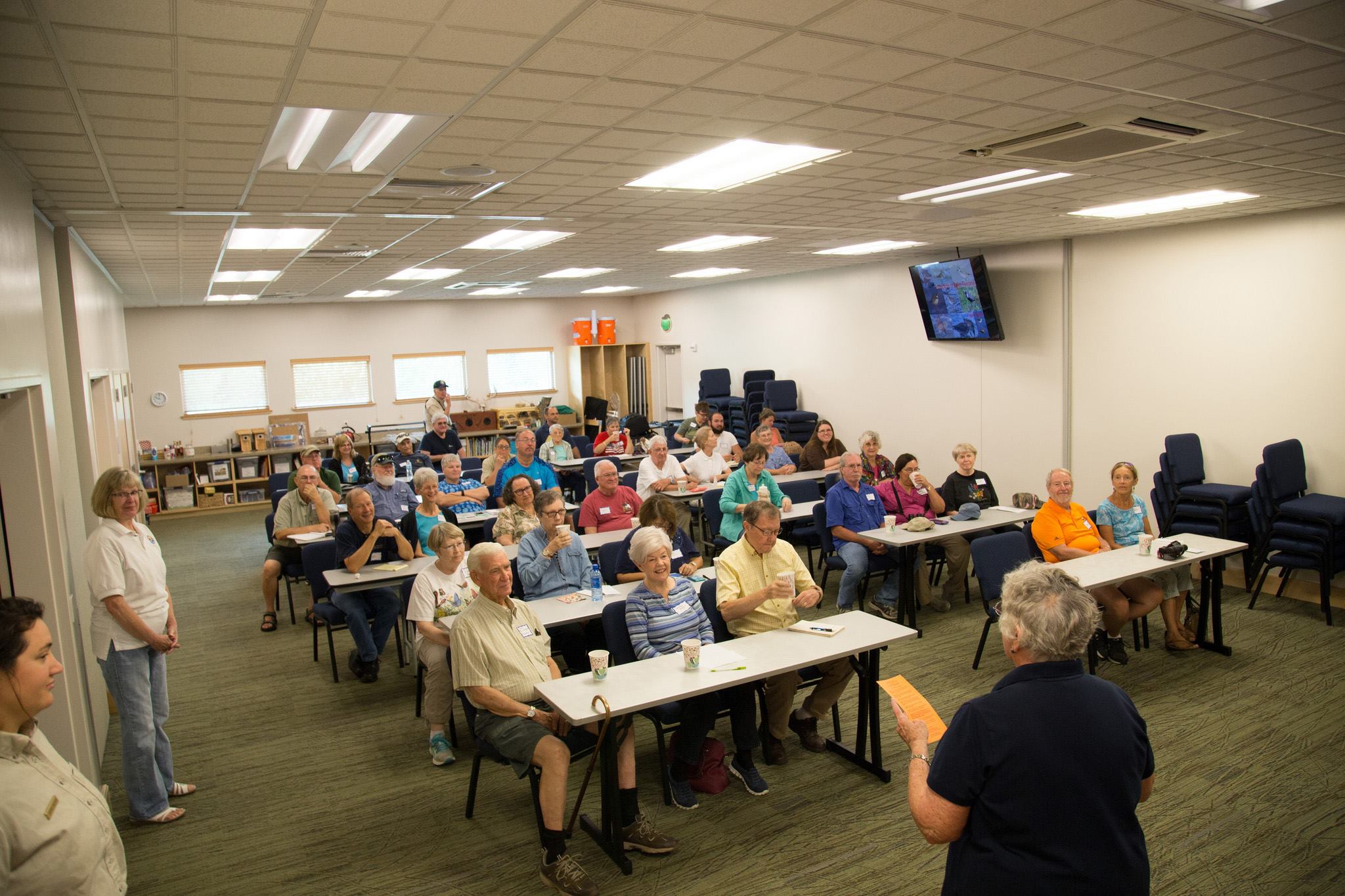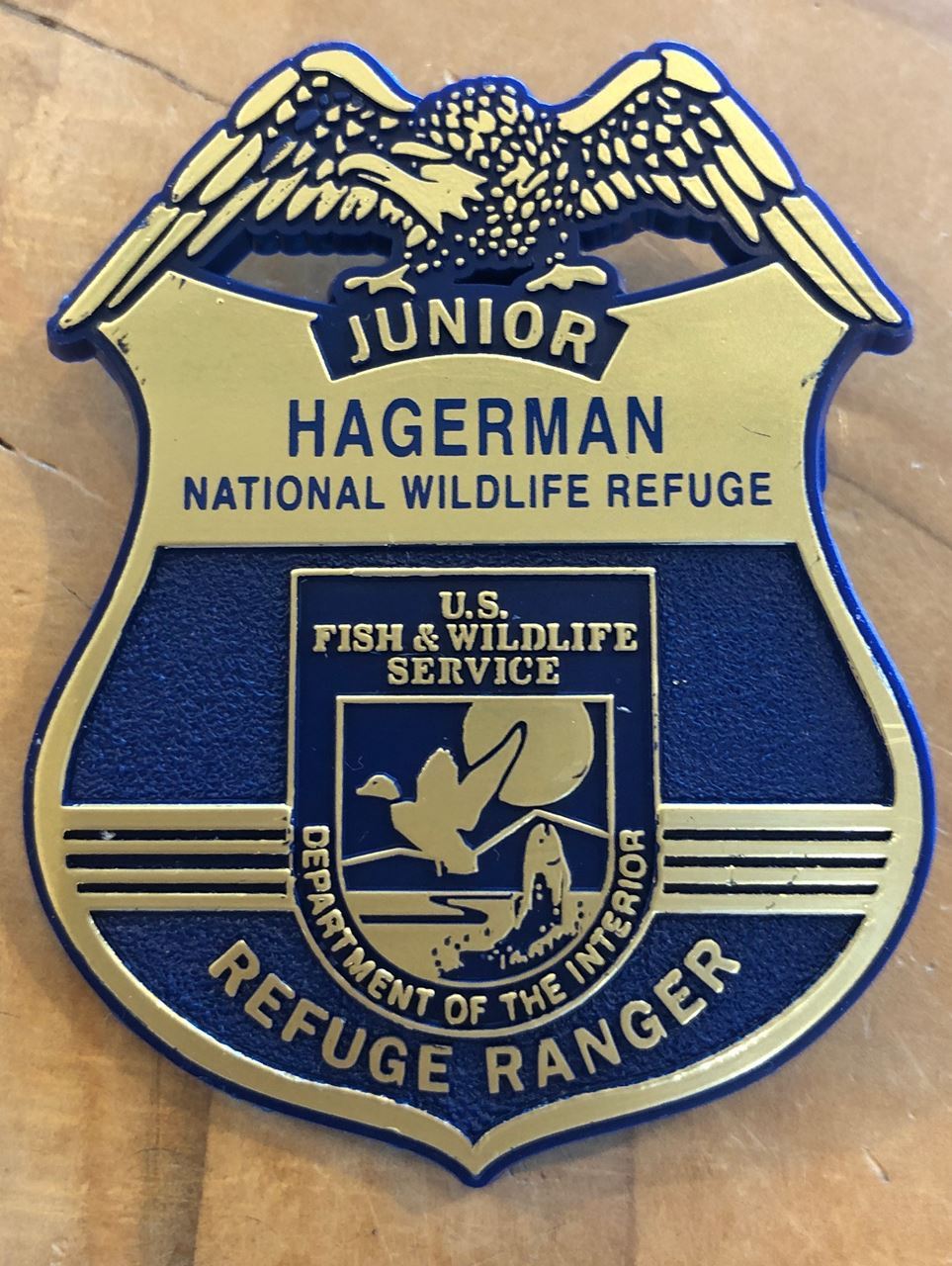So Glad for the Auto Tour! By Renny Gehman
The Auto Tour may take you past thousands of Snow and Ross Geese this time of year. Photo by Pam Rendall-Bass |
Did you ever plan a visit to Hagerman NWR, and then wake up to damp, cold day with a 25+ mph wind? That’s what happened to my husband, Bob, and I just before Christmas. Admittedly, I was headed there to write this article on the auto tour—but I was really glad I wasn’t writing about one of the trails instead! Like many of you, even though I’ve been going to Hagerman for over 20 years, I’d never driven the Auto Tour. There are signs all along the main road, but even though I’d mentioned the tour to visitors when I worked at the desk in Headquarters, I’d never followed it myself. I had a vague impression that you needed to sign up and get a CD to play, but I’d never tried it. How wrong I was! When I mentioned taking the Auto Tour to Bob, he wondered if we needed to get some recording or something in order to follow it. When I admitted I didn’t know, we both decided to approach our tour as if we were new visitors. So, the first thing we did was look up the Auto Tour on the Friends of Hagerman website, and we discovered that the Auto Tour narrative was available to download to our cell phones! No need to stop by the office at all! Unless, that is, you want to borrow one of the binoculars available for check out at the Visitors’ Desk. However, let me state the obvious—the Visitors’ Center is well worth visiting. The volunteers are extremely helpful and knowledgeable, they know where special birds/animals have been spotted recently, and there is a wonderful gift shop full of nature-themed items and gifts. Not to mention clean bathrooms. Bob and I decided that morning, because of |
the weather, to simply download the Auto Tour to my phone and follow it without any further explanations. So I typed into my phone: friendsofhagerman.org/auto-tour, and we were off! You may see several Great Blue Herons along the Auto Tour, as they are plentiful at the refuge. Photo by Laurie Sheppard The instructions tell you to proceed to the informational kiosk on Refuge Road directly across from the visitor center driveway. This is the starting point for the Tour, and where you can pick up a map to follow. I used this stop to log into the Auto Tour on my phone and listen to the first two audio tracks. The first one is just a general introduction reminding you to follow Refuge rules, but the second one describes the first Trail you encounter when you enter the Refuge. Harris Creek Trail has 3 loops: of a ¼ mile ADA loop, 1 mile and two miles. The Tour narrator recommends taking the stroll, the first of five maintained paths which the Tour will pinpoint for you. Because of the weather, Bob and I stayed in the car, but we’ve both taken Harris Creek Trail in the past, and highly recommend it. Next, the narrator tells you to leave the kiosk and head north on Refuge Road to the intersection and turn left. This is Wildlife Drive, the main road through the refuge, and the turn was well signed. The narrator tells you to continue southwest until you see the sign for stop 1 on your right. When you pull into the turnout, also on your right and slightly ahead is the Big Mineral arm of Lake Texoma, while across the road on your left is a broad field where you might see your first flock of snow geese. The narrative continues with a detailed description of the Refuge’s history, including the town of Hagerman and the formation of Lake Texoma. |
Many species of birds may be visible along the auto tour.
Left: Cedar Waxwings by Donnie Simmons
Right: Snow Geese by Pam Rendall-Bass
After finishing the history, Track 3 continues, telling you to proceed along Wildlife Drive to Stop 2, about ¼ mile farther along. This stop gives you a long vista where, if it is winter, as our drive was, you may be overlooking thousands of snow geese and other waterfowl. The geese were missing because of the weather, but it’s still a good view of the lake. The narrator explains the Refuge’s farming program, and highlights the fishing which is so much a part of the Refuge’s attraction.
You’re then told to continue for about ½ mile and make a right onto Tern Road. The eventual destination is the pull-off at Stop 3, but often as you make the turn you can spot waterfowl in the marsh on your right. The narrator identifies this as Muleshoe Marsh, with Steedman Marsh on the left of your car.
Proceeding up the road, you come to Stop 3, where you should begin listening to Track 4. The narrator explains the oil and gas leases, which offer both distraction and opportunity as you travel Hagerman’s roads and trails. The track also describes issues threatening the refuge, such as invasive wildlife and plants. Then you’re instructed to continue on Tern Road until you come to the crossover road on your left that will take you to Egret Road.
Traveling along Egret, it’s easy to see many waterfowl and wading birds. The road is narrow, so both sides give a good view. Stop 4 is well marked, but the platform referenced is no longer there due to flooding. This is still a good spot to notice a wide variety of birds.
Northern Harrier by Brenda Kay Edwards
From Stop 4, the Tour guide has you continue down Egret Road back to Wildlife Drive where you’ll make a left and then take an immediate right onto Silliman Road. This is well marked by signs, so it’s hard to miss even though it happens very soon. Continuing up Silliman, you’ll come to the next stop and the head of Crow Hill Trail. Silliman passes through open fields, as the narrator explains, and we were able to get closer pictures of the flocks of geese.
The Auto Tour then instructs you to turn around in the Crow Hill Trail parking lot and head back to Wildlife Drive, where you’ll turn left. You’ll continue 3/4 of a mile down the road before you’re able to follow the next instruction which is to turn right on Bennett Lane. Then you’ll see Stop 6 ahead, which is the entrance to the Big Mineral Day Use Area.
Track 7 explains all the things you can do at Big Mineral, listing several trails you can follow, and also explains other parts of the Refuge accessible by car. The final message given in Track 8 just thanks you for following the Tour and reminds you to bring any audio device back if you borrowed one from the Visitor’s Center.
And, that’s it! Depending on how long you spend at each stop, the Tour can take you anywhere from a half hour to several hours if you stop to walk some trails. Bob and I didn’t walk any this time but we did stop to take pictures, so our trip took about an hour and a half. And, as familiar with the Refuge as we were, we learned a lot! The narration was very interesting, although I will note here that some details were not currently accurate—like an overlook on Egret which has been removed.
I also had a bit of a problem getting each new track to play when we stopped. I’m not sure if that was my internet connection, or just that the tracks took a while to load. I did finally get them all to play, and, as I said, found each one informative.
Was it worth it, even on a cloudy, cold, windy day? YES! As I said, we learned a lot—and were pleasantly surprised by all the birds we were able to spot, even with the waves on Lake Texoma looking like ocean waves. So for older folks like us, or others with restrictions that make it hard to walk around, the Auto Tour was fun, engaging and convenient. We might just repeat it this coming summer when the temperatures make us reluctant to leave our air-conditioned car!
Enjoy the Auto Tour today!
Refuge Update: Though refuge lands are open from sunrise until sunset every day of the year, the Visitor Center is open Monday through Saturday 9-4, Sunday 1-5. Come and see the Snow Geese! Special Closure: The Meyers Unit and associated Raasch Trail will be closed to the public from the evening of January 9th (Thursday night) through 12th January (Sunday night). The rest of the refuge will remain open to the public. |
Photos by Brenda Kay Edwards More Amazing Nature Photos taken at the refuge (Facebook account required.) |
Upcoming Activities:
The Friends of Hagerman is Hosting 13 Family Friendly Events in January! Donate to help fund programs like these! |
|
Rewilding Sticker Hill: It’s Alive!!! Article VII of our Rewilding Series Left: Possumhaw, Ilex decidua, just before it dropped the rest of its leaves. The birds have been feasting on berries all month. A few more Cedar Waxwings and it will be picked dry! Right: A Carolina moonseed vine, Nephroia Carolina, growing up a shortleaf pine, Pinus echinata. Winter has arrived, the leaves are rapidly piling up, and the native habitat has begun its preparation for Spring. During one of my recent walkabouts, I spotted a few new plants with bright red berries that are quite popular with local birds. The first one, possumhaw, or deciduous holly, Ilex decidua, was tucked in behind a redbud tree down by the pond. It has loads of bright red berries and lost almost all of its leaves during December. The berries are poisonous to us, but they provide quality food for the birds and small mammals all winter. The second plant, Carolina moonseed, Nephroia carolina, was growing up a large shortleaf pine. From a distance, before I saw its bright red berries, I thought it was green briar, but it had no thorns, and the leaves were quite different up close. Its berries are also poisonous, but the birds have no problem consuming them. No doubt birds are the source of the new plantings. All of the late boneset and marsh fleabane have finally gone to seed. These two members of the sunflower family are generous when it comes to providing seeds for foraging wildlife. Native bees often use the tall stems to lay eggs and safely overwinter, too. In the past, when I would deadhead taller plants, I left at least 2-3 feet of stem in place for bees. This is good practice, but I finally stopped cutting the dried seed heads. So many plants in this family are designed to hold on to their seed heads all winter, where they provide food for local birds and small animals. The plants make the perfect storage and feeder systems for their seeds, keeping the food clean and available until it is either eaten or spread around the habitat. These two plants are welcome to fill in any spots they find convenient, since they are always covered with pollinators all season.
|
Fire Prevention Grant Article and Photos by Nan Beth Campbell Photo taken on Haller's Haven Trail by Nan Beth Campbell What’s going on around the refuge? Literally, AROUND the refuge. If you walk Haller’s Haven trail or drive down to Sandy Point, you may notice light blue ribbons, wide areas where all the undergrowth is gone and only the largest trees remain, and shredded mulch on the ground. Soon other areas around the refuge will show off this new look. Why? Hagerman NWR and the Wichita Mountains National Wildlife Refuge received funding for community protection from wildfire through the Bipartisan Infrastructure Law. These two sites are closest to large population areas in the Texas/Oklahoma region where wildfires pose a significant risk to both property and people. The funding is being used to mechanically thin vegetation along portions of the refuge boundary. Much of the boundary contains dense stands of undesirable woody species including mature eastern red cedar, winged elm, honey locust, and bois d’arc trees. The overall goal of the project is to reduce the risk of wildfire spreading from refuge lands onto private lands, and minimizing the associated damage to private lands- including oil and gas infrastructure both on and off the refuge. Per Kathy Whaley, Refuge Manager, a contractor will create the fuel-break along approximately 37 miles of the refuge boundary under a contract that calls for clearing 89 acres a year for 4 years. ● All standing trees within 20 feet of the boundary line will be mechanically removed or shredded unless they are high-value trees. The 20-foot cleared line may not be straight which will allow marked trees to be avoided. ● An additional 100-foot-wide section, beginning at the edge of the 20-foot-wide cleared section, will be mechanically thinned to remove the same undesirable species. All oak and hickory trees with a DBH (diameter at breast height) of six inches or greater located within the 100-foot-wide section will be left undisturbed. ● The contractor will be using tracked and wheeled machines that provide the lowest ground pressure possible. ● No digging, grubbing, or pushing of vegetation will occur. ● Shredding with a masticator and cutting with saws or equipment is permitted and all stumps will be cut flush with ground level. ● Cut material will be evenly distributed and not average more than eight inches in depth on the ground. ● Trees too large to shred will be removed from the site or burned on-site using air curtains, fire boxes, or other efficient means that will not create a wildfire threat. There will be no pile burning. ● The contractor will access the area only during daylight hours and generally on weekdays. If the areas are too wet to handle heavy equipment, the work will be postponed in that specific area to minimize impacts to wildlife habitats and soils.
The linear corridor around the boundary will support prescribed fire operations, improve access for refuge staff to complete habitat work, and enhance emergency response capabilities. The boundary areas will be maintained by the US Fish and Wildlife Service via prescribed fire, our forestry cutter, and brush hog mower. Bushwackers Land Clearing is the contractor responsible for clearing the non-water refuge boundaries. You can learn more about how to protect your home and property from wildfires at the National Forest Service, and from FEMA. Let’s all do our part to prevent wildfires. |
Second Saturday: Bluebirds with Kathy Whaley Saturday, January 11, 2025 at 10:00 AM in the Visitor Center Photo by Chris Balsamo In this presentation about Eastern Bluebirds in North Texas, the focus will be on the habitat, behavior, and conservation efforts of this iconic species in the region. The presentation will highlight the bird's nesting habits, diet, and migration patterns, emphasizing the steps taken by the refuge to support their habitats and survival. Additionally, it will address the challenges faced by Eastern Bluebirds, such as habitat loss and competition for nesting sites with invasive species like house sparrows. Conservation efforts, including the installation of bluebird boxes and monitoring programs, will also be explored to show how volunteers may contribute to the protection and recovery of this species. Future Second Saturday Programs |
|
|
Join the Butterfly Garden Docents Do you love butterflies and native plants, like to learn new things, enjoy being outdoors and meeting new people, and like helping others learn? Then consider joining the Hagerman Butterfly Garden Docent Program!
For more information contact: Kim Tingle friendsofhagerman@gmail.com Texas Master Naturalist HNWR Butterfly Garden Docent Program Chair |
Birding with Jack: The Weekly Bird Census Left to Right: Mike Petrick, Nancy Riggs, Jack Chiles and Terry Goode Each Tuesday a team of experienced birders, including Master Naturalist Jack Chiles, traverse 35 miles of refuge roads and hiking trails, documenting every bird they encounter. This Bird Census is reported to The Cornell Lab of Ornithology for use in research, and each week we will bring you a link to their actual bird count, and a summary of their adventures. December 31, 2024 Complete Bird Census 75 Species Observed, +2 other taxa, 3,769 individuals It was a chilly, breezy day for our last bird census of 2024. We started the day out by going to the Goode Area. There were a lot of birds feeding on berries near the entrance to the Goode Area and in the large Juniper, near the entrance, that is always loaded with berries in the wintertime, we found a female Purple Finch feeding on the berries along with a Ruby-crowned Kinglet as well as some Northern Cardinals. Later on Wildlife Drive we saw about 1200 white geese on the lake. The geese numbers are way down this week but the majority might be going out on neighboring fields during the day. On the far west side of the refuge we had two good finds, a flock of 6 Inca Doves in an oak tree near a private residence and 10 Wood Ducks in the creek near the juncture of Old Sadler Road and Crawford Road. Duck numbers were good with 12 species present today. The more numerous species were, 447 Northern Pintails, 292 Green-winged Teals. 237 Gadwalls and 98 Northern Shovelers. We saw a Winter Wren near the long bridge on Meadow Pond Trail. We saw a total of 58 Northern Cardinals and nine species of sparrows. We finished the day with 75 species. Today's photos, Purple Finch, Ruby-crowned Kinglet and a Winter Wren. HAPPY NEW YEAR! See the rest of Jack's notes and the latest Bird Census Results |
The Friends of Hagerman NWR Photo Club Presents: Aviation Photography with Jay Miller January 18, 2025, 1:00 PM – 3:00 PM in the Visitor Center Join us for the January meeting of the Friends of Hagerman NWR Nature Photography Club. Photo club members, guests, and visitors are welcome to attend meetings. Jay Miller will be discussing the art and science of aviation photography, both static and air-to-air, via a Keynote presentation. There will be plenty of images and a display of a few tools of the trade. He’ll cover a little of aviation photography's history, the equipment requirements, and the over-arching safety concerns that are part and parcel of working around flying machines for a living. Jay’s side-hobby is nature photography, so included will be a few images more germane to the Club’s raison d’être! Questions will be most welcome! Jay has been in the aviation photography business for well over sixty years. Concurrently, he has worked as an aviation photojournalist, an aviation museum director, an aviation history lecturer, a script writer and fact checker for the television industry, and the author of some 36 books and over a thousand newspaper and magazine articles on aviation subjects. His photography clients have included Boeing, Lockheed Martin, Northrop Grumman, Bell Helicopter, Airbus, and many smaller subs and completion shops. He lives in Ft. Worth, is married, has two adult daughters, and two grandmunchmkins. We are fortunate to have Miller speak at our photo club and tell us about his adventures of capturing photos of aviation throughout the years.
Event Leader: Lisa Wilkins _____________________________________________ For questions about the photo club, contact: Lisa Wilkins, Photo Club Leader Email FOHphotoclub@gmail.com |
| Puddles' Craft Corner By Cindy Steele, Master Naturalist |
Sensational Snowflakes!
Welcome back to Puddles’ Craft Corner. It’s January! It’s that time when we think about the cold weather, and that means thinking about things like building snowmen, snowball fights, snow angels…in other words – SNOW! Here in the North Texas/Southern Oklahoma area we usually don’t see snow until January or February, if we even see snow at all. We might be making paper snowflakes at school or at home, dreaming of waking up to a snowy wonderland.
When we do get snow, it’s a magical experience…especially out at Hagerman NWR. If you happen to be out at the refuge during or after a snow, the whole refuge takes on a different sound and look and the animals are out in abundance enjoying the cold. Since most kids in January are dreaming of snow…and snow days off from school, let’s learn a little bit about snow before we dig into a fun craft.
How Are Snowflakes Formed?
To understand how snow forms, we have to know a little bit about why it rains. When water becomes warm, it evaporates as water vapor into the air, forming clouds. When it cools again above our heads the vapor turns back to water and rain falls back down to the ground. When it’s really cold, the water vapor freezes into crystals, usually around a particle of dust in the cloud. As this tiny particle of ice moves through the clouds, more water vapor freezes to it. Eventually, this process creates a snowflake that is heavy enough to fall from the clouds to the earth. If it’s cold and dry on the ground, the snow won’t melt. Instead, each flake of snow will land on top of the other, causing the snow to build and cover the ground. Did You Know That All Snowflakes Are Six-Pointed? Snowflakes are made up of many of these tiny frozen crystals. Usually, one of these snowflakes is made up of about 200 of these connected ice crystals. Snowflakes are made up of six sides and six points. Because of the way they stick together, the frozen droplets make a shape with six sides. Each one of these six-sided shapes is called a snow crystal. As more and more droplets stick to the snow crystal, they start sticking to the...
Continue the Lesson With Full Instructions and other Nature Crafts with Puddles
Junior Ranger Program
|
| The Junior Ranger Pledge As a Junior Ranger at Hagerman National Wildlife Refuge, I pledge to protect outdoor creatures small, big and huge. To keep the water, air and land clean. To make enjoying nature a routine. I will share my new skills with family and friends. When people and nature work together, everybody wins! |
|
Sponsors Enable the Friends to…
Join Today! Memberships available for $10 |
Come, Take a Tour on the Wildlife Explorer! Come join us for a ride on the Wildlife Explorer! Our new and beautiful tram is available for ninety-minute tours of Hagerman every Saturday and Sunday, weather permitting. Our tours are as varied as our drivers. Each tram driver has her/his approach to the tour: you may learn about wildlife, birds, habitat, refuge history, photography, you name it! To paraphrase, “a Wildlife Explorer tour at Hagerman is like a box of chocolates, you never know what you’re going to get.” But you know it’s going to be good! Come see us! Lots of stops for bird-watching and photography. |
Register for a Tram Tour Today! |
|
|
Photo by Cathy Van Bebber | Sunrise at the Little Sit by Laurie Sheppard |
Meet Jack and the Bird Census Team and learn how to identify the birds of North Texas while enjoying the beautiful sunrise over Lake Texoma! Modeled after Cornell's national "Big Sit" event, a group of dedicated birders invite you to join them at sunrise to conduct a bird count as multiple species fly to the water and the surrounding land to feed. Leaders will bring spotting scopes and will provide tips for identification of the many species you will see. This event lasts a couple of hours, but all are welcome to come and go as they please. Participants are advised to bring a chair, binoculars and water. The First Saturday of every month, beginning 30 minutes before sunrise. |
Location: H Pad, Sadler, Texas 76264 (H Pad is in Sadler, but it is part of the refuge) GPS Coordinates: 33.734961, -96.780582
|
|
Early Bird Walk with Jack Chiles Master Naturalist Jack Chiles will lead our Early Birding event, weather permitting. Bring binoculars or borrow ours. Meet at the Visitor Center and return in time for the Second Saturday program. Please Register (Optional) so we may inform you via email of unforseen changes/cancellations. |
Do You Like to Work Outside? The Refuge Needs You! |
It takes a lot of people to have a beautiful garden! The Wednesday Garden Team Love to work with native plants and meet other gardeners? Come and help us add plants, weed and mulch our beautiful butterfly garden. Garden Team volunteers get first dibs on thinned native plants as well as access to seeds and cuttings for propagation. Gardeners meet on most Wednesdays, but times vary. Contact Us to subscribe to the volunteer garden team weekly email. Provide own tools and gloves. Minimum age 18, or 16 if accompanied by parent/volunteer. |
Mowing and Refuge Beautification: The Work Crew Do you enjoy working outside, mowing, sprucing up hiking trails, trimming and removing brush and general cleanup? Show your love for nature by joining the Outdoor Crew at Hagerman National Wildlife Refuge. Outdoor Crew volunteers meet on the First Tuesday and Fourth Saturday of every month. Contact Us for exact times, dates and other details about joining the volunteer Work Crew. Scouts welcome! |
Visitor Center Volunteers Needed! |
Do you enjoy meeting all kinds of people from all over the world, and like-minded people in our area? If yes, consider joining our team of Visitor Center Volunteers. You will greet refuge guests, distribute maps and other refuge information, and make sales in the gift shop. Shifts available every day of the week: Monday through Saturday 9 AM to 12:30 PM and 12:30 to 4:00 PM, Sunday 1:00 to 5:00 PM. Training is provided. Contact Us if interested. |
| Thank You To Our Contributors: Nan Beth Campbell, Jack Chiles, Brenda Kay Edwards, Renny Gehman, Karen Glenn, Laurie Sheppard, Donnie Simmons, David Sinclair, Cindy Steele, Skip Stevens, Refuge Manager: Kathy Whaley Deputy Refuge Manager: Paul Balkenbush Visitor Services Manager: Spencer Beard Friends of Hagerman NWR Foundation 6465 Refuge Road, Sherman, TX 75092 Phone: 903-786-2826 Join us on Facebook: www.facebook.com/groups/HagermanPhotoClub (Facebook account required) |
Search for any word--do not use quotes for phrases |
Kroger: Stop by the customer service desk at Kroger and link your Kroger Card to the Friends of Hagerman: the Friends will get rewards for every dollar you spend, at no cost to you.
Please add info@friendsofhagerman.org to your contacts to ensure delivery of registration confirmations, account information and the Featherless Flyer
See you at the refuge!






















